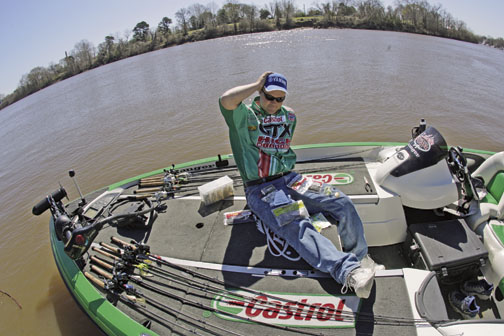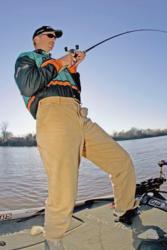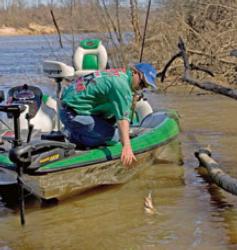Junk fishing
Fast and furious fishing works when fish scatter after the spawn

Several years ago, during a post-tournament interview, Castrol pro David Dudley claimed to have caught his bass “on junk.”
I was shocked to hear Dudley refer to his productive lures in such a way.
Seconds later, Dudley cleared the air: He was not referring to his lures, but his “pattern.”
“I call it junk fishing,” he clarified. “That’s what I call the absence of a pattern – when you have 15 rods on the deck and you’re running around the lake like a madman, fishing anything and everything.”
Recently, the term “junk fishing” has become a bit of a buzz word on the pro tours. As Dudley points out, it refers to the lack of a definitive pattern, when bass seem to be scattered from the shoreline down to 20 feet and everywhere in-between.
“You start the day with 15 rods on your deck – a topwater, Carolina rig, jig, worm, fluke, tube, deep-diving crankbait, spinnerbait and whatever else. By the end of the day, if you’ve caught a bass on each rod, then you’ve been junk fishing,” Dudley explained.
Junk fishing is one of Dudley’s most preferred fishing methods, mainly because he has won so much money by doing it.
Though he fishes “junk” throughout the year, Dudley reveals that May is the month junk fishing really shines.
“During the prespawn, fish tend to move up together in bunches and groups,” Dudley described. “That’s when you need a more rifle-type approach – get in one area, with one technique and grind it out. But after the spawn, fish scatter out everywhere, and that’s when you need more of a shotgun approach, covering more areas with more techniques.”
 Ozark Trail pro Andy Morgan of Dayton, Tenn., has also corralled a lion’s share of FLW Outdoors winnings by junk fishing, and he agrees that May is a “junkie’s paradise.”
Ozark Trail pro Andy Morgan of Dayton, Tenn., has also corralled a lion’s share of FLW Outdoors winnings by junk fishing, and he agrees that May is a “junkie’s paradise.”
“May in the south-central part of the country is that transition time when fish are doing everything: A few fish are still on beds, some are guarding fry, some are taking advantage of the shad spawn and some are already on the deep ledges. They are everywhere, but not really grouped up anywhere.”
To define the primary junk-fishing window more specifically, Morgan points to April 25 through June 10, or when water temperatures range from 72 to 80 degrees.
“Also, junk fishing is best on reservoirs that have different bass species and a good shad base,” Morgan said. “Since smallmouths, spotted bass and largemouths tend to spawn at different times, having two or more of these species in a lake helps spread the postspawn out even more.”
Even though it’s called junk fishing, Dudley says there is a method to the madness.
“During the postspawn, definitive patterns are all in limbo – some patterns are going away and some are getting better – and junk fishing is really about sampling each of those patterns during a fishing day,” he advised.
A typical May junk-fishing run for Dudley might start by blitzing a couple stretches of riprap where postspawn bass are feeding on shad.
“A buzzbait or spinnerbait is usually a good choice for this,” he offered.
Then he may run toward the dam and try topwater for schooling fish for a few minutes.
On his way back up the lake, he will hit a few choice ledges or breaks with a deep-diving crankbait to pick off the first fish that might be gathering on the ledges.
 “After the sun gets up, I’ll try some main-lake grass beds where bass are still guarding fry,” he said. “By the end of the day, I might be way up the river trying to catch a late spawner still on the bed. And in all that running around, I won’t be afraid to flip any docks or lay-downs that look good.
“After the sun gets up, I’ll try some main-lake grass beds where bass are still guarding fry,” he said. “By the end of the day, I might be way up the river trying to catch a late spawner still on the bed. And in all that running around, I won’t be afraid to flip any docks or lay-downs that look good.
“To me, that’s junk fishing in May – a sampler’s platter of several patterns,” he summarized.
Morgan defines junk fishing as fishing fast and staying on the move.
“This is not the time to be milking an area or slowly fishing long stretches of bank,” Morgan said. “You want to assault the sweet spots with a dozen casts and then move on. The water is warming, the whole food chain has picked up the pace, and you have to do the same.”
Morgan defines postspawn sweet spots as primary breaks off big spawning flats, riprap, bridge pilings, lay-downs, docks, main-lake or “outside” grass beds where the last bass have spawned, and shade.
“Shade is key that time of year,” he said. “As the sun gets up higher during the day, the shade along the bank becomes scarce, and bass fry will gravitate toward any isolated shadows for protection.”
Another reason for fishing fast is to beat the competition to the apparent cover.
“A lot of junk fishing is hitting obvious stuff that everyone can see,” Morgan said. “And that time of year, the early bird gets the worm. It’s not like prespawn, where water temperature and timing have a lot to do with getting bites. Most bites happen on the first cast or two.”
“That’s why fishing fast is so critical,” Morgan added. “You want to get to the next sweet spot before someone else does.”
Dudley adds that the object of junk fishing is not necessarily to catch a limit off each spot, but rather just a fish or two.
“Obviously, if the fish are biting, don’t leave,” he said. “But if you catch a fish on your first cast and then don’t get another bite for a while, there’s no point in fishing the place for an hour – move on.”
Another important aspect of junk fishing is to fish from your gut.
“Junk fishing is instinctive, and that’s why I like it so much,” Dudley said. “Many times in tournaments, I’ll be riding down the lake and see something that just catches my eye – an isolated lay-down, a small stretch of bank grass or a flat point – and even though I’ve never fished there before, I’ll pull in and give it a couple of casts. Junk fishing in May is a great time to let your instincts find the fish for you.”
“It’s also a great way to avoid fishing pressure,” Morgan added. “By May, most of the springtime spawning hot spots are tapped out, but guys keep going back to those memories. Once the fish spread out, junk fishing allows you to catch fish in those vacant blind spots in-between the community holes.”